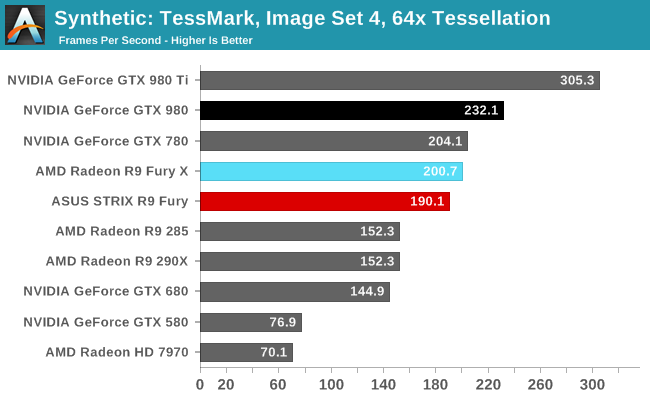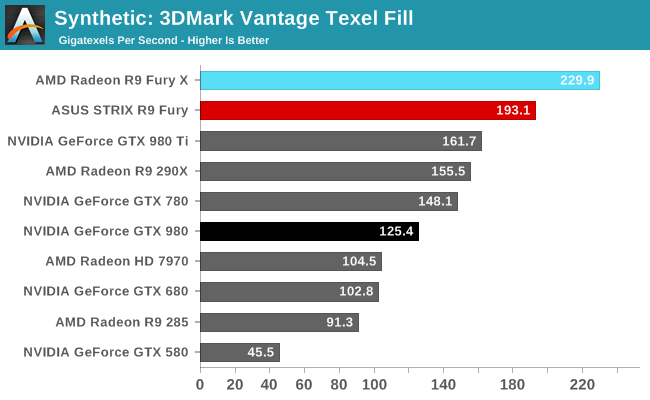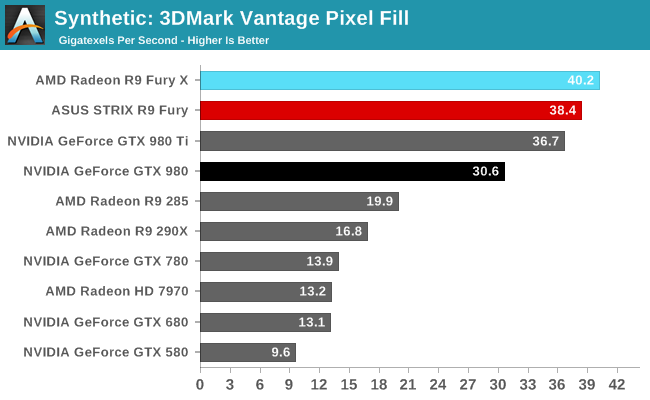The AMD Radeon R9 Fury Review, Feat. Sapphire & ASUS
by Ryan Smith on July 10, 2015 9:00 AM ESTSynthetics
As always we’ll also take a quick look at synthetic performance. Since R9 Fury is a cut-down and lower clocked Fiji part, what we’re expecting here is a significant shader/texture hit, with a much smaller hit to tessellation and pixel throughput.

TessMark scores more or less perfectly scale with clockspeed in this case. The R9 Fury is almost precisely 5% behind the R9 Fury X.


As for 3DMark Vantage, the performance hits are in-line with expectations. The R9 Fury takes a pretty significant hit to texturing performance due to the combination of lost texture units and the clockspeed reduction, while pixel throughput trails by just under 5%. This indicates that at least for the purposes of the 3DMark test, the R9 Fury series is ROP bottlenecked rather than memory bandwidth bottlenecked, a consequence of AMD’s excellent delta color compression.










288 Comments
View All Comments
Oxford Guy - Thursday, July 16, 2015 - link
"What exactly is the logic there?"I really need to spell it out for you?
The logic is that the 480 was a successful product despite having horrid performance per watt and a very inefficient (both in terms of noise and temps) cooler. It didn't get nearly the gnashing of teeth the recent AMD cards are getting and people routinely bragged about running more than one of them in SLI.
CiccioB - Thursday, July 16, 2015 - link
No, it was not a successful product at all, though it was still the fastest card on market.The successful card was the 460 launched few months later and surely the 570/580 cards which brought the corrections to the original GF100 that nvidia itself said it was bugged.
Here, instead, we have a card which uses a lot of power, it is not on top of the charts and there's really no fix at the horizont for it.
The difference was that with GF100 nvidia messed up the implementation of the architecture which was then fixxed, here we are seeing what is the most advanced implementation of a really not so good architecture that for 3 years has struggled to keep the pace of the competitions which at the end has decided to go with a 1024 shaders + 128bit wide bus in a 220mm^2 die space against a 1792 shader + 256bit wide bus in a 356mm^2 die space instead of trying to have the latest fps longer bar war.
AMD, please, review your architecture completely or we are doomed with next PP.
Oxford Guy - Tuesday, July 21, 2015 - link
"No, it was not a successful product at all"It was successful. Enthusiasts bought them in a significant number and review sites showed off their two and three card rigs. The only site that even showed their miserable performance per watt was techpowerup
Count Vladimir - Thursday, July 16, 2015 - link
So we are discussing 6 year old products now? Is that your version of logic? Yes, it was hot, yes, it was buggy but it was still the fastest video card in its era, that's why people bragged about SLI'ing it. Fury X isn't.Oxford Guy - Tuesday, July 21, 2015 - link
"So we are discussing 6 year old products now?" strawmancelebrevida - Thursday, July 16, 2015 - link
Looks like Jason Evangelho of PCWorld has the matter settled. In his article:http://www.pcworld.com/article/2947547/components-...
He shows that R9 Fury x2 is on par with GTX 980 Ti x 2 and blows away GTX 980 x2. Considering that R9 Fury x2 is much cheaper than GTX 980 Ti x2 and also R9 Fury is optimized for upcoming DX12, it looks like R9 Fury is the clear winner in cost/performance.
xplane - Saturday, October 17, 2015 - link
So with this GPU I could use 5 monitors simultaneously? Right?kakapoopoo - Wednesday, January 4, 2017 - link
i got the sapphire version up to 1150 stably using msi after burner w/o changing anything else